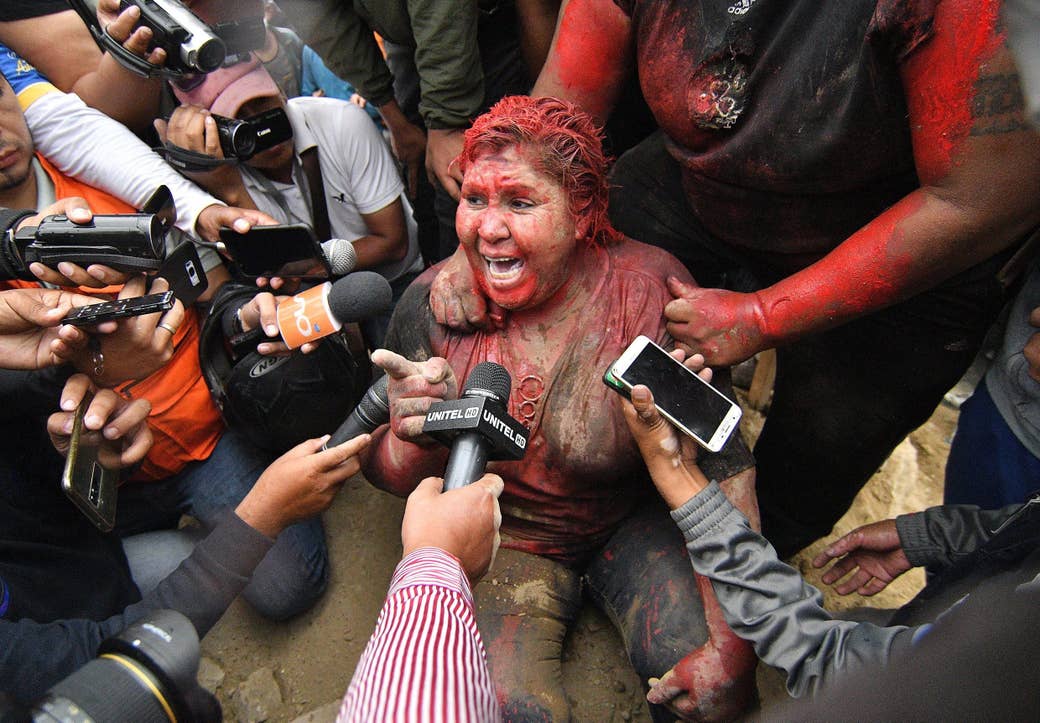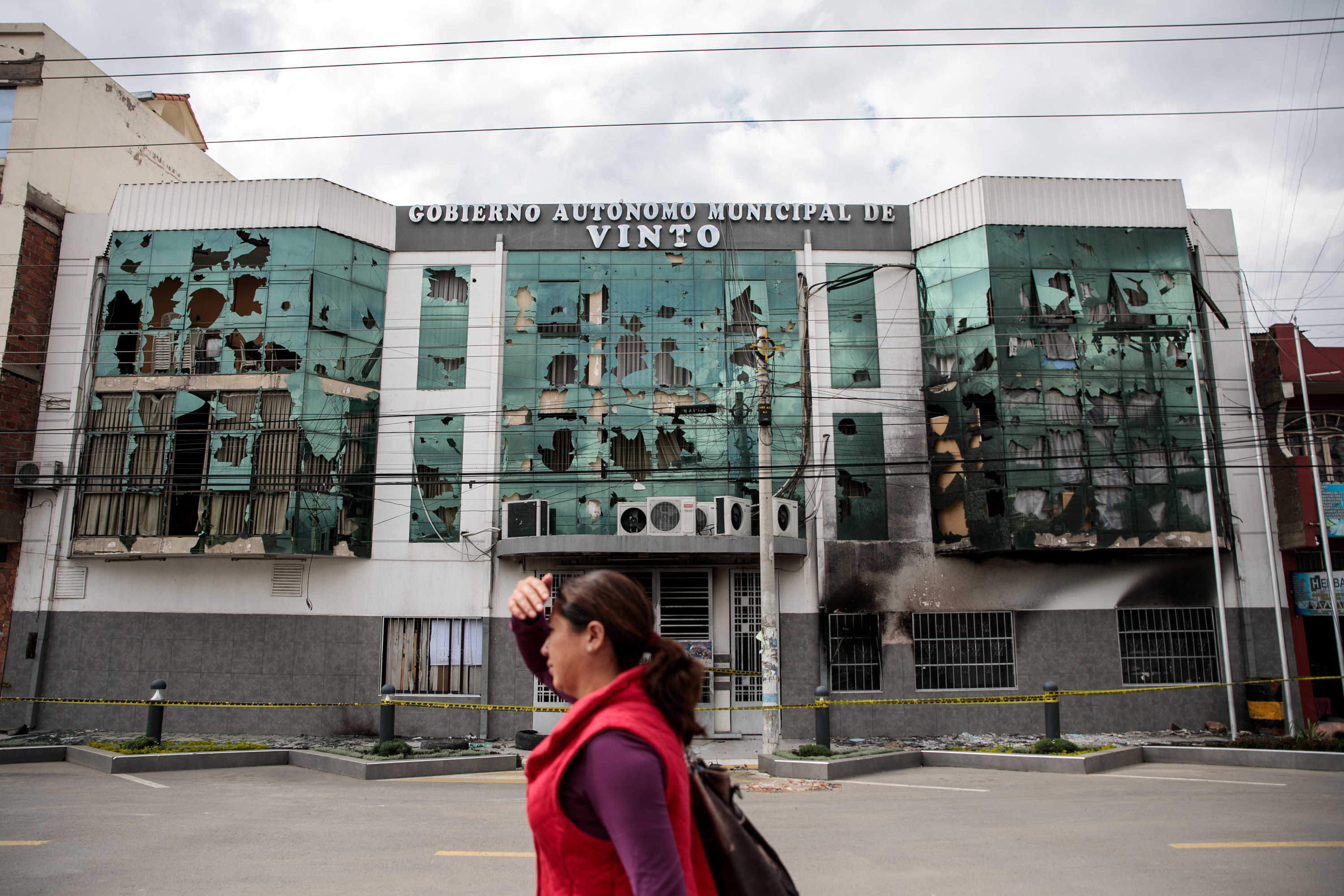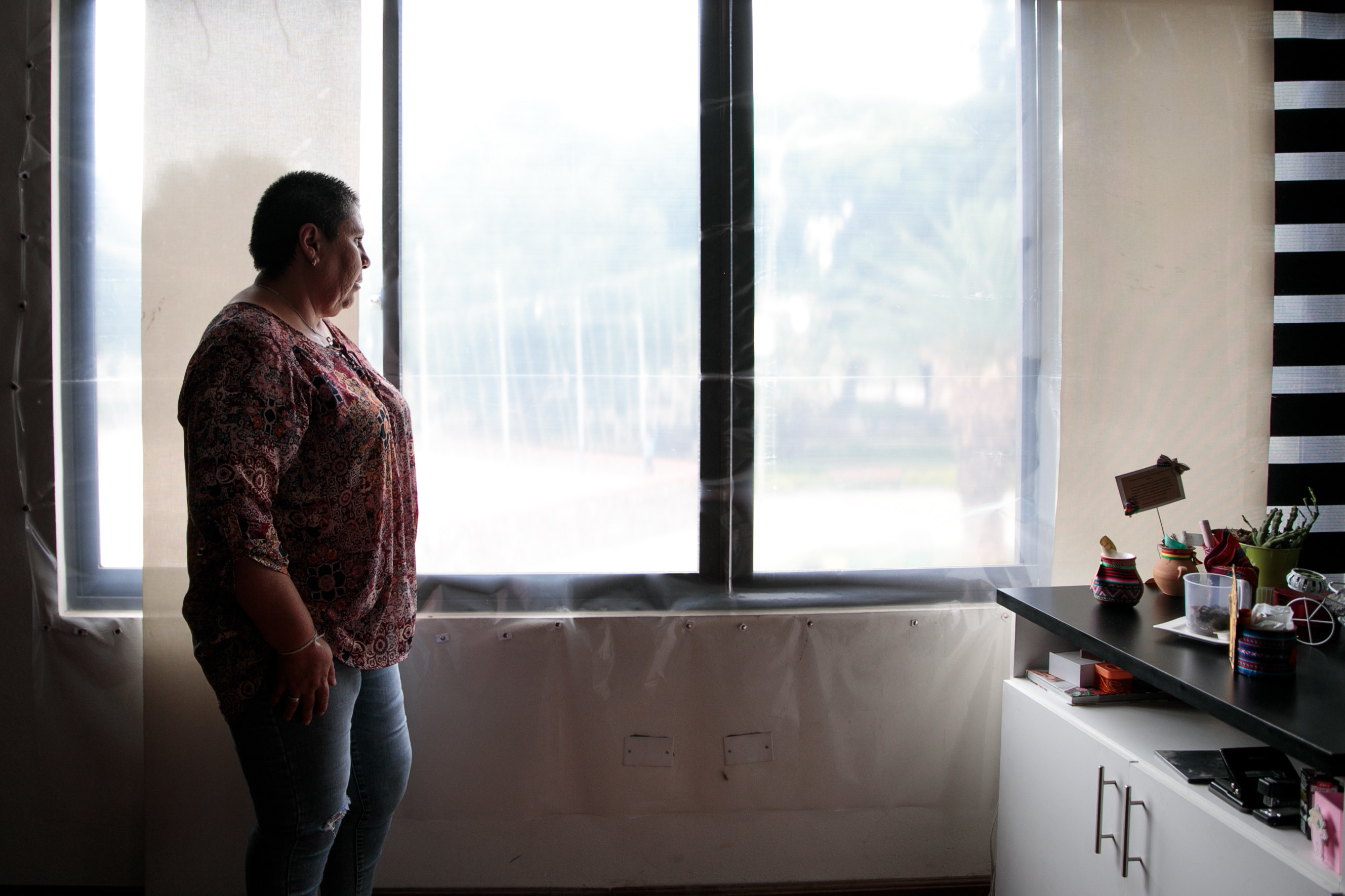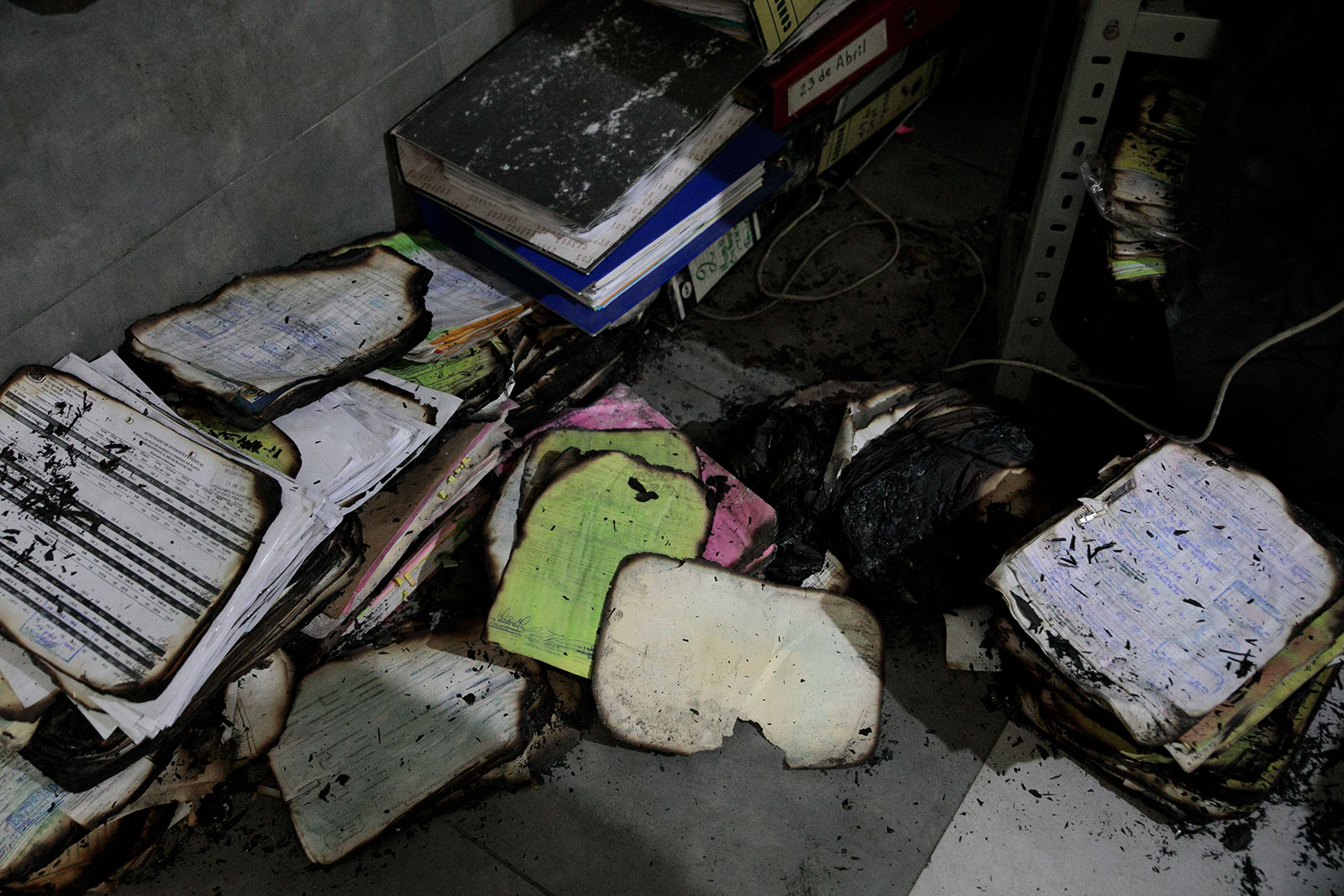VINTO, Bolivia — First, they tried to rip Patricia Arce’s clothes off.
When she fought back, the masked men came down on her with sticks, beating her until she passed out. When she came to, they pulled her up, removed her shoes, and forced her to walk down a long street covered with broken glass.
The frenzied crowd led Arce, the mayor of Vinto, a small town in central Bolivia, away from her office. They said they were walking her to her death. Along the way, someone doused her with red paint and gasoline. Then a woman rushed up to her and chopped off clumps of her hair, at one point slicing a chunk of her scalp off.
Videos of the assault, which took place last month, were quickly uploaded to social media and went viral around the world within hours, showing Arce looking shell-shocked. When the crowd finally came to a halt 3 miles down the road, a man forced Arce down on the ground, stood behind her, and grabbed one of her breasts. “We are live, we are live!” someone yelled before he removed his hand.
By then, a handful of local reporters had caught up to them, and planted microphones in Arce’s face. They asked her to recount what she had just been through. Arce, 48, was still being held against her will by the mob even as she tried to speak.
“Resign!” a chorus of people shouted in the background. Suddenly defiant, Arce said she wasn’t afraid, and that if anything happened to her or her children, the country’s emboldened right-wing opposition should be held responsible.
When Arce, a lawyer and mother of three, first got into politics five years ago, she could never have expected it would lead to this: beaten, humiliated, and turned into an international symbol of political violence.

The attack came in the middle of political upheaval in Bolivia after a contested election in which the president, Evo Morales, narrowly won a fourth term in a highly controversial process. With rule of law virtually suspended across the country at the time of her assault, Arce was forced to go into hiding temporarily.
Outside Bolivia, the conflict quickly became a Rorschach test, simplified into a duel between authoritarianism and democracy, left against right, rich versus poor. At home, the opposition to Morales, the country’s first indigenous president, included people from across the ideological, political, and class spectrum who were fed up with official corruption. But political allegiances aside, Arce’s story provides a warning tale of the human cost of political violence.
Arce was able to escape alive and remains in office. BuzzFeed News traveled to Vinto and spent two days with her. A month after the attack, Arce’s soles were covered in bruises and cuts; she remained under medical supervision for injuries to her kidney sustained during the assault. She spoke of how the attack was a reminder of how brutal life can be for women in the deeply sexist country.
“This was a message for all women here,” she said, sitting on a bench near where she was attacked, “that we still cannot occupy public spaces.”

Trouble started brewing almost two weeks earlier, on October 25, when electoral authorities announced that Morales had narrowly won a fourth presidential term. Massive street protests broke out, convulsing the country and pitting Morales’ political allies — including Arce — against the opposition.
At least 36 people died in the postelection crisis, and dozens of houses and government buildings were set on fire.
It was in the middle of this tense climate that Arce walked onto a makeshift stage with Morales on Friday, November 1. The sun was beating down on Vinto as the two inaugurated a new irrigation channel, the latest infrastructure project delivered by the Movement for Socialism, or MAS, Morales’ and Arce’s party.
Vinto, a sleepy town of around 60,000 people, had for years been one of Morales’ strongholds. Arce, too, enjoyed popularity, particularly among women. She had spent much of her time in office since 2015 spearheading women’s empowerment programs and convincing husbands to let their wives work.
Despite this, Arce has at times found herself at the center of local conflict. Last year, local council members denounced Arce for allegedly handing over control of a Vinto hospital to the police through an agreement they said was illegal, according to local news reports.
But the day when Morales and Arce inaugurated the irrigation project wasn’t meant to be controversial. It was, instead, intended to be a rallying cry for Morales’ supporters to resist amid growing postelection trouble.
“I am not afraid. If I have to give my life to protect this political process, I will!” said Arce. She warned the crowd not to let “a handful of rascals,” including opposition leader Luis Fernando Camacho, spread panic across the country’s poor as the political crisis reached an impasse.
The following day, Camacho, the rosary-carrying entrepreneur and president of the Civic Committee of Santa Cruz, a politically influential civic group, set a 48-hour deadline for Morales to resign.
Morales — who had lifted thousands out of poverty; built schools, markets, and hospitals in historically forgotten corners of the country; and maintained a relatively robust economy throughout his 13 years in power — had lost a referendum in 2016 in which he had asked Bolivians if he should run for a fourth term. He decided to run anyway, and narrowly won. After an audit of the results, the Organization of American States found “clear manipulation” in the voting process, including the burning of some electoral records and an unexplained interruption in the transmission of results.
Tensions intensified after Camacho’s ultimatum to Morales. On November 6, pro- and anti-Morales groups clashed in nearby Quillacollo, and a young man was killed. Many there accused Arce of having recruited pro-government workers from Vinto and adjacent towns to march to Quillacollo and provoke the confrontation. Arce has denied the charge.

That afternoon, Arce had just finished lunch in her office when the building suddenly came under attack. From the main highway, men threw rocks at the windows and started a fire on the ground floor. With Vinto’s 22 police officers away providing support in Quillacollo, Arce was virtually defenseless. Her security adviser told her to run out through the back entrance.
Arce expected to find her driver waiting for her outside. Instead, the street was empty except for a group of men; they marched toward Arce and took her hostage. An eye for an eye, they said: She had incited the deadly clash in Quillacollo, so now she must die. But not before a walk of shame.
“Fucking murderer!” the men around her shouted. Arce’s gait was determined, but her eyes appeared round with fear. Her shirt and jeans dripped with bright red paint. One mile. Then two. Then three.
When they arrived in Quillacollo, Arce was unrecognizable, her hair shorn, and reeking of gasoline and urine. Her assailants forced her to the ground; they ordered her to resign and speak critically of Morales as she looked into the collection of cellphones they had shoved in her face.
Across town, Pedro Herrera had been scrolling through Facebook when he suddenly came upon a face he knew well: his mother’s. In the video, Arce was forced by dozens of men to walk down the street. She appeared to faint a number of times, and the men beat her while she was conscious. Immediately, Herrera, 24, told his two younger siblings what was happening, got in his car, and sped toward the crowd. But by then, Vinto had become a battleground, and many of the streets were blocked by people on motorcycles and by piles of burning tires.
Herrera wasn’t able to rescue his mother.
Several hours after the attack began, a couple of unidentified men retrieved Arce from the crowd and delivered her to a police officer, who sped away with her on a motorcycle. That day, Arce arrived at a clinic 90 minutes away from Vinto — anywhere closer would have been too risky, she was told — where nurses scrubbed the red dye from her using paint thinner. It made her skin, already burned by the gasoline, sting even more, Arce said.
Several days later, while she recovered in the clinic, a nurse told Arce that she was no longer safe there and needed to find another hospital.
She went into hiding.

Arce reappeared, almost two weeks later, wearing a dirty blonde wig, still under the effects of a cocktail of pain medications. She sat at a blue-clothed table in her office building, flanked by a couple of staff members, to deliver her first press conference since the attack. A dozen microphones and recorders were piled in front of her.
During Arce’s time in hiding, the crisis in Bolivia had only intensified: The police had turned on Morales, and the head of the military had “suggested” he resign. Morales fled to Mexico under the cover of night. Political violence had become deadlier; at least 18 people were killed in two separate massacres.
For the first time since Morales came to power in 2006, the political balance had shifted to the right. Jeanine Áñez, a conservative lawmaker and the highest-ranking member of the country’s legislature after a series of resignations by MAS legislators, had proclaimed herself interim president, thrusting a huge Bible in the air. One of her first moves was to issue a presidential decree granting immunity from criminal prosecution to security forces participating in operations to “reestablish internal order,” prompting immediate pushback from human rights organizations.
Arce’s own crisis had deepened too. Barely able to walk because of the cuts on her feet, she had spent countless hours thinking about what was happening to her country: What kind of children were Bolivians raising? How could people harbor so much hate? But one thing was clear: She had to go back to work.
There had been fevered, outlandish speculation about Arce’s attack. One reporter asked Arce if she had ordered the assault on herself, echoing rumors floated by critics of Morales’.
“It’s shameful to think that someone would do this to herself,” she told the journalist. “I may have been orphaned at two, but I was raised with values and principles.”
Video of the press conference, which was uploaded to Facebook, elicited ridicule from some of her critics in the comments, including suggestions that she get a better wig and that she be nominated for an Oscar for her “acting.” Peppered amid the mocking comments were messages of support and praise.
On a recent Sunday afternoon, Arce slowly got out of her car and limped over to a bench in Vinto’s main town square across the street from her office. She was no longer wearing a wig — “It shows strength to walk around without it,” explained Arce — revealing a pair of small silver earrings. Her lips were carefully painted a light pink to match her sweatshirt. She looked around as a police car drove repeatedly around the square.
“I’m afraid,” she said. “We are raising monsters, not people.”

Arce held up her phone to show pictures of her assailants she had been sent. Each of them had their name superimposed on them, but despite knowing who they are, she doesn’t expect to get justice. Indeed she may face prosecution herself after the prosecutor’s office in Cochabamba, a major city nearby, opened a complaint against her for “separatism” and “improper use of public goods and services.” The prosecutor’s office did not respond to a request for comment from BuzzFeed News.
The following day, Arce arrived at her office at 6 a.m. for a meeting, wearing a flowy shirt, jeans, and flats. Less than half-an-inch long, her hair has grown out white in some spots — because of stress, she said — and she touched it self-consciously from time to time. Her office had also undergone an unwanted transformation: A plastic sheet covered the gaping hole where the mob had broken a window. Her desk was empty; protesters had entered her office that day and broken her computer.
Groups of local residents filed into her office throughout the morning, demanding that she mediate neighborly conflicts or sign contracts on upcoming public works. She listened carefully, responded in Quechua — an indigenous language she taught herself when she became mayor five years ago — and took notes. People hugged her on their way out; if they had looked closely, they would have been able to see a speck of red paint on her necklace, a remnant from the attack.
“To have quit or to have kneeled down would have been a betrayal of all women,” said Arce, looking worn-out. Still, she is considering taking time off to grow vegetables and flowers when her mayoral term is over next year. Perhaps take up basketball, a lifelong passion of hers, again.
Downstairs, a group of interns and staffers sat around a couple of desks trying to conserve half-burned tax documents. Most tax records had been torched when the building was attacked, and the smell of charred paper lingered in the air.
Before lunch, Arce, surrounded by several of her staff members, visited the public registry office to fill in some paperwork. To get there, she had to walk through the local market, where more than a dozen women — most of them wearing aprons, as they had been working in their fruit stalls — walked up to Arce and hugged her.
Back in the car, Arce took a deep breath. How did she feel? “Insecure,” she said.
During the first days after the attack, she would call her therapist five or six times a day, in addition to the two weekly in-person sessions they had, she said. Arce had installed cameras at home and set up the camera feed in her bedroom, next to her bed.
Three different wigs, in various shades of blonde, hung from wall lamps. A dozen hair products sat on her sideboard next to a blow-dryer, a hair iron, and a hairbrush. Arce was cuddled up on her bed, holding hands with her youngest son, 16, who has spent every night with her since the attack.
If she forgets the attack for a moment, someone in Vinto is likely to remind her, she said. A few days after she had returned to work, Arce was walking out of her office when she saw a familiar-looking man waiting in line at one of the counters. Suddenly, she remembered his face: He was one of her attackers.
As if on autopilot, Arce walked toward him. “Hello. I’m all right, despite what you did to me,” she told him.
The man stammered something unintelligible, she said, and bowed his head in shame. ●





